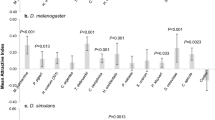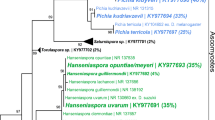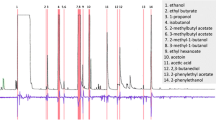Abstract
Fermented molasses or sucrose solutions are known to attract several species of filth-breeding flies. To identify the volatile attractants produced in fermenting sucrose solutions with yeast, these solutions were fractionated, and the chemical constituents identified and bioassayed against filth-breeding flies includingFannia canicularis (L.),Muscina stabulans (Fallén), andMusca domestica (L.). Distillation of a fermented sucrose solution gave an active distillate and an inactive residue. Gas Chromatographic analysis of the distillate showed the presence of acetaldehyde, ethyl acetate, ethanol, 1-pro-panol, 2-methyl-l-propanol, and 3-methyl-l-butanol. Ethanol constituted by far the greatest proportion of compounds present in the distillate. An aqueous solution of ethanol exhibited the same level of attractancy as the distillate, the fermented sucrose solution, and a reconstituted distillate containing all compounds identified. Ethanol was thus identified as the sole attractant emanated from fermented carbohydrate solutions that elicited positive responses in pest flies, especially inF. canicularis.
Similar content being viewed by others
References
Brown, A.W.A., West, A.S., andLockley, A.A. 1961. Chemical attractants for the adult house fly.J. Econ. Entomol. 54:670–674.
Burnett, H.S., Parneke, W.E., Lee, R.D., andWagner, E.D. 1957. Observations on the life cycle ofThelazia californiensis Price 1930.J. Parasitol. 43:433.
Eyer, J.R. 1931. A four-year study of codling moth baits in New Mexico.J. Econ. Entomol. 24:998–1001.
Hwang, Y.-S., andMulla, M.S. 1971.Hippelates eye gnat attractants. 1. Isolation and identification of ether-soluble coattractants produced by fermentation of whole-eggsolids.Ann. Entomol. Soc. Am. 64:1086–1091.
Hwang, Y.-S., Mulla, M.S., andAxelrod, H. 1976. Attractants for synanthropic flies. Identification of attractants and coattractants forHippelates eye gnats (Diptera: Chloropidae).J. Agric. Food Chem. 24:164–169.
McIndoo, N.E. 1933. Olfactory responses of blow flies with and without antennae, in a wooden olfactometer.J. Agric. Res. 46:607–625.
Mulla, M.S., Hwang, Y.-S., andAxelrod, H. 1977. Attractants for synanthropic flies. Chemical attractants for domestic flies.J. Econ. Entomol. 70:644–648.
Peterson, A. 1924. Some chemicals attractive to adults of the onion maggot(Hylemyia antiqua Meig.) and the seed corn maggot(Hylemyia cilicrura Rond.).J. Econ. Entomol. 17:87–94.
Peterson, A. 1925. A bait which attracts the oriental peach moth (Laspeyresia molesta).J. Econ. Entomol. 18:181–190.
Reed, M.R. 1938. The olfactory reaction ofDrosophila melanogaster Meigen to the products of fermenting banana.Physiol. Zool. 11:317–325.
Richardson, C.H. 1916. The response of the house fly to ammonia and other substances.N.J. Agric. Exp. Stn. Bull. 292.
Shinohara, T., andWatanabe, M. 1976. Gas Chromatographic analysis of higher alcohols and ethyl acetate in table wine.Agric. Biol. Chem. 40:2475–2477.
Sychevskaia, V.I., Grudtsina, M.V., andVryvikhvost, L.A. 1959. The epidemiological significance of synanthropic flies (Diptera) in Bukhara.Entomol. Obozren. 38:568–578.
Vanskaya, R.A. 1942. The use of ammonium carbonate for the control ofMusca domestica L.Med. Parasitol. 10:562–567.
Wietino, J.O.G., andHoskins, W.N. 1939. The olfactory responses of flies in a new type of insect olfactometer. II. Responses of the house fly to ammonia, carbon dioxide and ethyl alcohol.J. Econ. Entomol. 32:24–29.
Williams, J.R.P. 1973a. The control ofFannia canicularis (L.) in poultry houses using impregnated cords.Br. Poult. Sci. 14:547–555.
Williams, J.R.P. 1973b. Trichlorthon syrup baits for control ofFannia canicularis.Int. Pest Control 15:22–24.
Author information
Authors and Affiliations
Additional information
Diptera: Muscidae.
Rights and permissions
About this article
Cite this article
Hwang, Y.S., Mulla, M.S. & Axelrod, H. Attractants for synanthropic flies. J Chem Ecol 4, 463–470 (1978). https://doi.org/10.1007/BF00989502
Received:
Revised:
Issue Date:
DOI: https://doi.org/10.1007/BF00989502




